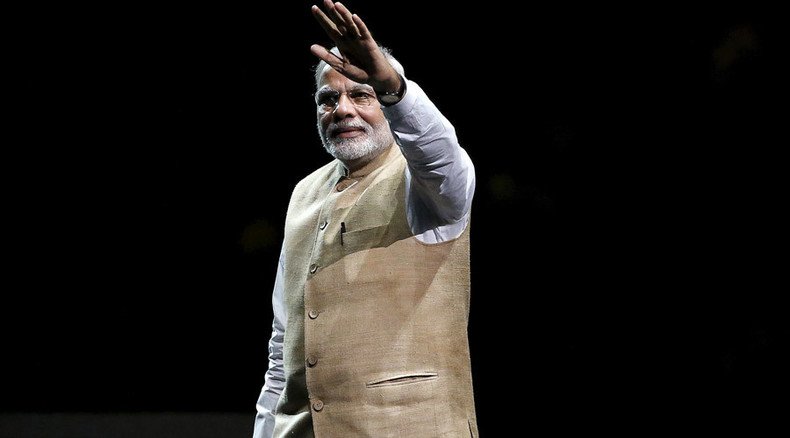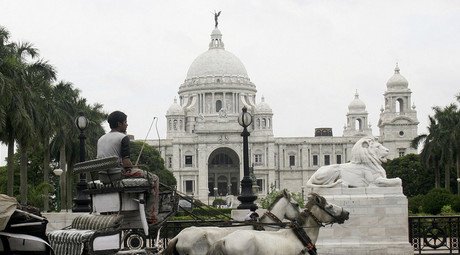Modi in London: Everything you need to know about Indian PM’s UK visit

Indian Prime Minister Narendra Modi arrived in London on Thursday for a three-day official visit, the first of any Indian leader in almost a decade.
The Hindu nationalist leader will dine with the queen, attend business talks and express his support for tighter UK/India ties.
However, Modi’s visit is not popular with some British Indians, many of whom plan to protest during the visit.
RT examines the key points.
Why is Modi in London?
In the run-up to the visit, Modi detailed the importance of his visit for defense and cooperation in a series of Facebook posts. He said the visit will be used to develop “strong ties” in defense, an area the two countries have traditionally “cooperated extensively.”
“Defense manufacturing will be a prime focus in my talks,” he wrote.
Modi said energy is also high on his agenda. He said he is committed to providing clean energy to the population of India in cooperation with the UK.
“There will be deliberations on clean energy and I will seek to achieve progress in our endeavor to make clean energy more affordable and accessible for the 1.25 billion people of India.”
Other areas of discussion include greater links between India and the UK in science, technology and education.
Narendra Modi UK visit: Corbyn & Salmond sign motion urging Cameron to raise human rights https://t.co/0g86Ea7ifepic.twitter.com/7XmFsoTdmw
— RT UK (@RTUKnews) October 22, 2015What’s on Modi’s agenda?
During the three-day tour Modi will be hosted by the queen at Buckingham Palace, as well as meeting British Prime Minister David Cameron in both London and his country residence, Chequers.
The Indian PM will also address the British parliament.
“I thank the Speaker of the House of Commons for this opportunity, considering that the UK Parliament is not in session,” he posted.
“I will address the City of London at an event at The Old Library, Guildhall. There will also be a visit to the Jaguar Land Rover factory at Solihull.”
“In London, I will pay homage at the statue of Mahatma Gandhi, who is a great source of inspiration for the entire world,” the leader wrote.
Diamonds aren’t forever: Indians sue Britain for return of Queen’s ‘Koh-i-Noor’ crown jewel https://t.co/TkcplZkNnUpic.twitter.com/0w5ChB8vCv
— RT UK (@RTUKnews) November 9, 2015What will Britain get out of it?
Cameron has long made it known he wants Britain to have closer ties with India. In 2010 he said he wanted Britain to be India’s “partner of choice.”
However, years later, his wish remains unfulfilled. Data from 2014 showed India was only worth £2.2 billion (US$3.3 billion) of British exports, placing it behind other European countries such as Switzerland and Belgium.
“Everyone knows the relationship could be broader and deeper than it is,” said Lord Mandelson, former Labour business secretary, ahead of the visit.
Cameron will be hoping to secure a clutch of business deals with the nation he has tried so hard to court.
Does the visit mark a new chapter?
Modi said he is looking forward to engaging with the “innovative zeal” of “one of the fastest growing G7 economies,” suggesting he is ready to build a greater Anglo-Indian relationship.
“You would be interested to know that UK has the largest diplomatic presence in India and is the third largest source of foreign investment in our country,” he wrote.
“India too is the third largest source of FDI [foreign direct investment] (in terms of the number of projects) in UK. I see immense scope for our economic and trade relations to improve and this will benefit both our economies.”
Is everyone pleased about Modi’s visit?
Not quite.
Recent weeks have seen a spate of demonstrations organized by British Indians who see Modi as a perpetrator of hate and intolerance.
On Sunday evening protesters projected the image of a swastika onto the Houses of Parliament, along with the words “Modi not welcome.” More protests are planned during the leader’s visit.
Protestors raise various questions for @narendramodi , hopefully media will get some answers.
#ModiNotWelcomepic.twitter.com/kM7Fg8bGdK
— AwaazNetwork (@AwaazNetwork) November 12, 2015Secular group the Awaaz Network claimed responsibility for Sunday’s stunt, saying it was aimed at highlighting the way Modi uses religious symbols for authoritarian ends. The swastika is actually the OM sign in Hinduism.
“I think it sent a clear message that a large part of the Indian community here rejects the politics of hate and intolerance, wherever it takes place,” Awaaz Network representative Suresh Grover said.
Grover said more protests would take place to act against what they see as a nationalist agenda.
Large groups of British Sikhs calling on David Cameron not to welcome Modi. #ModiNotWelcome#ModiInUKpic.twitter.com/LkHDV1p6e4
— Priyanka Mogul (@priyankamogul) November 12, 2015“There will be people from Hindu groups, Muslim groups Dalits, who have been victims of many attacks [in India], women groups and anti-racism groups,” said Grover.













